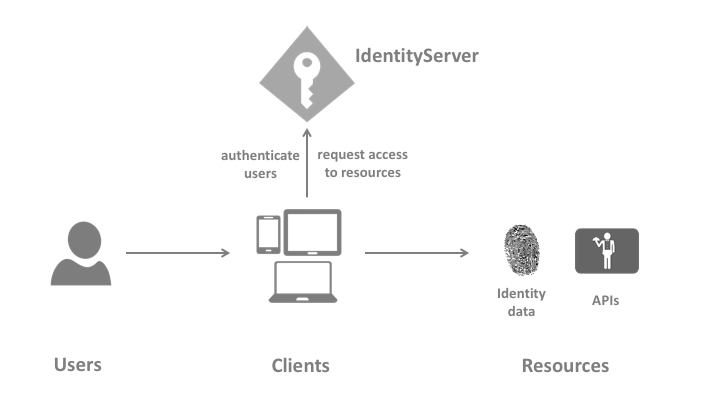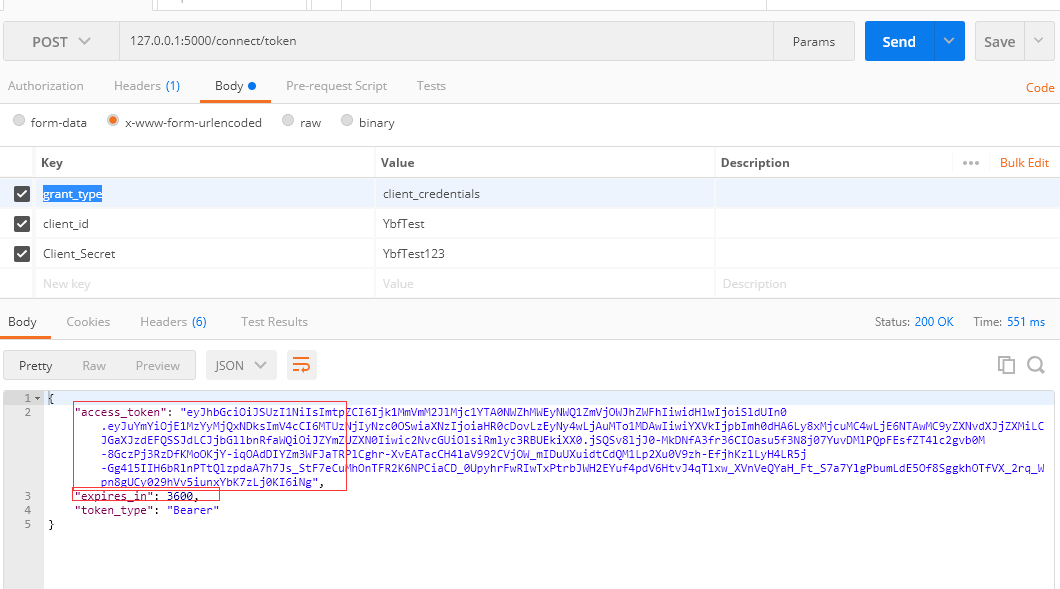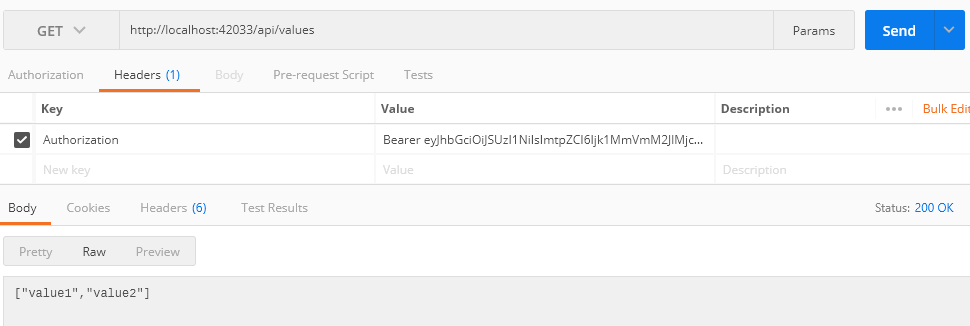【WebAPI No.3】API的訪問控制IdentityServer4
介紹:
IdentityServer是一個OpenID Connect提供者 - 它實現了OpenID Connect和OAuth 2.0協議。是一種向客戶發放安全令牌的軟體。
官網給出的功能解釋是:
- 保護您的資源
- 使用本地帳戶儲存或通過外部身份提供商對使用者進行身份驗證
- 提供會話管理和單點登入
- 管理和認證客戶
- 向客戶釋出身份和訪問令牌
- 驗證令牌
IdentityServe4的四種模式:
- 授權碼模式(authorization code)
- 簡化模式(implicit)
- 密碼模式(resource owner password credentials)
- 客戶端模式(client credentials)
以下是IdentityServer的一個大致流程圖:

註冊IdentityServe4認證伺服器:
先在asp.net core我們選中空模版。因為本身寫的業務也不多,只是為了做token的認證處理,所有建這個做測試比較方便。

建立程式碼示例:
什麼時候都不要忘記新增引用哦:
NuGet命令列:Install-Package IdentityServer4
當然你也可以這樣:

然後建立config.cs類來處理我們的一些業務:

//定義範圍 #region 定義要保護的資源(webapi) public staticView CodeIEnumerable<ApiResource> GetApiResources() { return new List<ApiResource> { new ApiResource("FirstAPI", "API介面安全測試") }; } #endregion #region 定義可訪問客戶端 public static IEnumerable<Client> GetClients() {return new List<Client> { new Client { //客戶端id自定義 ClientId = "YbfTest", AllowedGrantTypes = GrantTypes.ClientCredentials, ////設定模式,客戶端模式 // 加密驗證 ClientSecrets = new List<Secret> { new Secret("secret".Sha256()) }, // client可以訪問的範圍,在GetScopes方法定義的名字。 AllowedScopes = new List<string> { "FirstAPI" } } }; } #endregion
以上就是一個基本的處理類了。然後我們開始在Startup.cs 配置IdentityServer4:

public void ConfigureServices(IServiceCollection services) { services.AddIdentityServer() .AddDeveloperSigningCredential() .AddInMemoryApiResources(Config.GetApiResources()) //配置資源 .AddInMemoryClients(Config.GetClients());//配置客戶端 }View Code

public void Configure(IApplicationBuilder app, IHostingEnvironment env) { if (env.IsDevelopment()) { app.UseDeveloperExceptionPage(); } //將IddiTyServer新增到管道中。 app.UseIdentityServer(); app.Run(async (context) => { await context.Response.WriteAsync("Hello World!"); }); }View Code
這樣就可以啟動專案了,確認專案啟動完成後,還要確認服務是否開啟成功:在地址後增加地址:/.well-known/openid-configuration 例如:

出現以上結果就是啟動成功了。
當然你也可以使用postMan測試工具測試:
需要輸入
grant_type為客戶端授權client_credentials,client_id為Config中配置的ClientIdClient_Secret為Config中配置的Secret
例如:

建立webAPI資源伺服器
這個比較簡單了,首先建立一個簡單的webapi程式即可。
還是老規矩咯iuput,什麼時候都不要忘記引用:
通過nuget新增即可:IdentityServer4.AccessTokenValidation

然後點選確定安裝就可以了。
主要認證註冊服務:
在Startup類裡面的ConfigureServices方法裡面添加註冊
public void ConfigureServices(IServiceCollection services) { //註冊IdentityServer services.AddAuthentication(config => { config.DefaultScheme = "Bearer"; //這個是access_token的型別,獲取access_token的時候返回引數中的token_type一致 }).AddIdentityServerAuthentication(option => { option.ApiName = "FirstAPI"; //資源名稱,認證服務註冊的資源列表名稱一致, option.Authority = "http://127.0.0.1:5000"; //認證服務的url option.RequireHttpsMetadata = false; //是否啟用https }); services.AddMvc().SetCompatibilityVersion(CompatibilityVersion.Version_2_1); }
然後在在Startup的Configure方法裡配置Authentication中介軟體:
//配置Authentication中介軟體 app.UseAuthentication();
然後新增一個控制器進行驗證測試:
我這裡寫了一個獲取value值簡單檢測一下。
// GET api/values [HttpGet] [Authorize] public ActionResult<IEnumerable<string>> Get() { return new string[] { "value1", "value2" }; }
這裡注意要新增[Authorize]特性。用來做驗證是否有許可權的。沒有的話,以上做的沒有意義。需要引用名稱空間:using Microsoft.AspNetCore.Authorization;
看一下正確的請求結果:

如果不傳token值請求:

注意這裡就會返回401的未授權狀態。
建立Client(客戶端)
上面我們使用的是postman請求的以演示程式是否建立成功,這裡我們假設一個使用者的使用客戶端,這裡我們建立一個控制檯來模擬一下真實的小場景。
既然是控制檯就沒什麼好說的直接上程式碼main函式:

Task.Run(async () => { //從元資料中發現終結點,查詢IdentityServer var disco = await DiscoveryClient.GetAsync("http://127.0.0.1:5000"); if (disco.IsError) { Console.WriteLine(disco.Error); return; } //向IdentityServer請求令牌 var tokenClient = new TokenClient(disco.TokenEndpoint, "YbfTest", "YbfTest123");//請求的客戶資源 var tokenResponse = await tokenClient.RequestClientCredentialsAsync("FirstAPI");//執行的範圍 if (tokenResponse.IsError) { Console.WriteLine(tokenResponse.Error); return; } Console.WriteLine(tokenResponse.Json); //訪問Api var client = new HttpClient(); //把令牌新增進請求 //client.DefaultRequestHeaders.Authorization = new AuthenticationHeaderValue("Bearer",tokenResponse.AccessToken); //client.SetBearerToken(tokenResponse.AccessToken); client.SetToken("Bearer", tokenResponse.AccessToken); var response = await client.GetAsync("http://localhost:42033/api/values"); if (!response.IsSuccessStatusCode) { Console.WriteLine(response.StatusCode); } else { var content = await response.Content.ReadAsStringAsync(); Console.WriteLine(JArray.Parse(content)); } }); Console.ReadLine();View Code
這裡主要介紹一下請求資源時新增令牌主要有三種形式,我都在程式碼給出,根據api資源的註冊形式選擇適合的。api的註冊我也寫了兩種形式。主要的區別就是token前面的Bearer,如果想寫成自定義的和預設成Bearer就是這裡的區分。
自定義就要使用:
client.DefaultRequestHeaders.Authorization = new AuthenticationHeaderValue("Bearer",tokenResponse.AccessToken);
如果全域性預設的形式就不比每次請求都要新增所以可以寫成:
client.SetBearerToken(tokenResponse.AccessToken);
執行專案之後出現成功介面:


